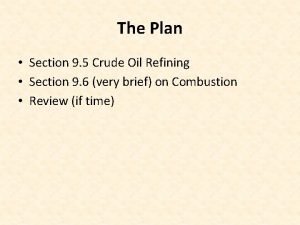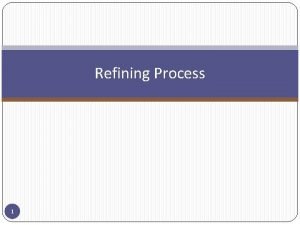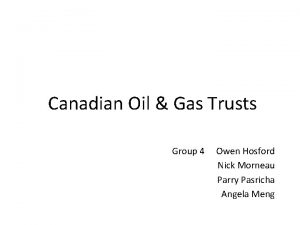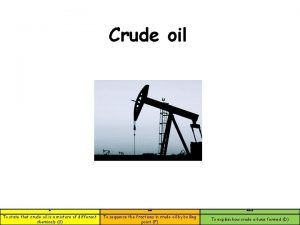Updating Monthly EIA Crude Oil Production Estimates for








- Slides: 8

Updating Monthly EIA Crude Oil Production Estimates for Oklahoma to Use Survey Data January 27, 2016 | Oklahoma City, OK Stephen Harvey Assistant Administrator Office of Energy Statistics U. S. Energy Information Administration Independent Statistics & Analysis www. eia. gov

EIA replaced its historical approach to modeling monthly oil production in Oklahoma with a survey-based estimate for 2015 • • After detailed review, EIA staff determined that estimates based on its expanded EIA-914 survey provide a better reflection of monthly Oklahoma production than the previous Average Lag Ratio approach (ALR). EIA-914 based estimates were published starting from January 2015. Comparison of Oklahoma Monthly Crude Oil Thousand Production Estimates, 2015 b/d 500 EIA-914 Estimate 450 The EIA-914 survey was expanded to collect oil production from the largest oil producers in 15 states and the Federal Gulf of 400 Mexico, including Oklahoma, beginning with January 2015 350 production. Definitional issues delayed publication of EIA-914 survey estimates for West Virginia for 2 months. At this time EIA publishes EIA-914 survey-based estimates for all areas including 300 Oklahoma. ALR Estimate 250 • • • The expanded EIA-914 survey replaced the ALR method for Oklahoma which had been based primarily on data published by the state. The ALR approach adjusts state reported data using historical patterns of delays in completion of those data. That approach would be inaccurate if delays in state reporting changed over time. For Oklahoma, estimates generated using the EIA-914 survey and the ALR model for 2015 are significantly different, with the ALR estimate lower than EIA-914 survey results. This presentation explains staff’s determination that the EIA-914 survey estimates for monthly Oklahoma oil production are superior, and decision to revise published 2015 Oklahoma production estimates was based accordingly. Stephen Harvey, Oklahoma City, January 27, 2016 200 State Data 150 100 50 0 Jan Feb Mar Apr May Jun 2015 Jul Aug Sep EIA-914 Estimate ALR Estimate State Data derived from aggregating DI data downloaded on January 20, 2016 2

EIA introduced surveyed monthly oil data in 2015 in an expanded EIA-914 survey • The EIA-914 survey is designed to capture monthly trends in oil production in a more accurate and timely manner. • The EIA-914 survey methodology uses a cut-off sample of the largest operators, as determined using lagged state data. • The EIA-914 survey has been used successfully to collect and publish monthly state-level natural gas production estimates for more than a decade. • Monthly oil production estimates based on EIA-914 survey responses were published starting with January production in June 2015 for 14 of 16 areas. – These estimates were consistent with ALR for 14 areas. – In West Virginia, definitional differences delayed publication until staff determined the surveybased estimates were more consistent with EIA published data for other states. • More than 100 operators in Oklahoma report on the EIA-914 survey, representing about 75% of total oil production. Stephen Harvey, Oklahoma City, January 27, 2016 3

Historically, EIA used the Average Lag Ratio Method (ALR) to estimate state-level monthly oil production volumes • ALR estimates are based mainly on data published by the state. – Historically, state data is incomplete when first published due to processing times, and becomes more complete over time. – ALR predicts what the eventual state total will be, after a lag period. – In effect, staff measures historical lag times between initial publication for a state and when the volumes stop changing. – An adjustment is applied based on that research. • ALR estimates predict results well when state data lags are systematic over long periods of time. • In 15 areas, the method compares well with EIA-914 survey estimates after accounting for the West Virginia definitional issues. Stephen Harvey, Oklahoma City, January 27, 2016 4

ALR model estimates in Oklahoma in 2015 were not higher than the sample responses collected for the EIA-914 and -182 surveys • In Oklahoma the subset of both EIA-914 and EIA-182 reported survey sample responses add up to a number close to the total for the state estimated by ALR, notwithstanding: – The EIA-914 survey is based on roughly 100 operator respondents, believed to represent about 75% of the total production in Oklahoma. – The EIA-182 is based on 25 first-purchaser respondents, believed to represent about 75% of the total production in Oklahoma. • The ALR appeared to be significantly under-reporting monthly oil production in Oklahoma. Monthly Oklahoma Production Volumes (thousand b/d) 450 400 350 300 250 EIA-182 Responses 200 EIA-914 Responses ALR Estimate 150 100 50 0 Jan 2015 Feb 2015 Mar 2015 Stephen Harvey, Oklahoma City, January 27, 2016 Apr 2015 May 2015 Jun 2015 Jul 2015 Aug 2015 Sep 2015 Oct 2015 5

Evidence for EIA-914 survey estimates • The EIA-914 survey has been used successfully for natural gas for over a decade. • EIA-914 oil survey estimates match ALR estimates in all other areas. • EIA-914 relies predominantly on reported, current production data obtained directly from producers, and is less reliant on state data than ALR. • Directly collected EIA-914 survey data from a subset of Oklahoma operators are higher than total ALR estimates. Stephen Harvey, Oklahoma City, January 27, 2016 6

Evidence against Average Lagged Ratio (ALR) • The subset of Oklahoma operators and first purchasers report higher numbers in aggregate on Forms EIA-914 and 182 than shown in ALR estimates. • ALR estimates must be low or both the EIA-914 and the 182 are incorrect. • ALR estimates are dependent on stability in the rate that states process production data – assuming unchanging and stable processes. • Oklahoma is known to have made changes in its processing in early 2015, which suggests that the revision pattern cannot be systematic, and continued use of ALR is inappropriate. Stephen Harvey, Oklahoma City, January 27, 2016 7

Appendix: Comparison of Data Stephen Harvey, Oklahoma City, January 27, 2016 8














